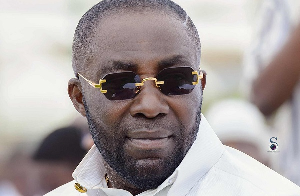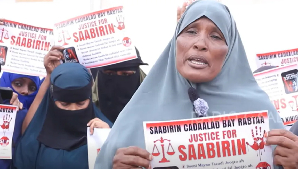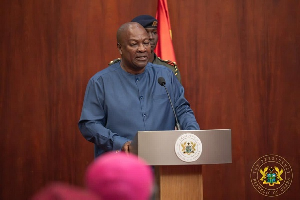*AKUFO-ADDO’s OFFICE: NDC MUST BE SINCERE TO FACTS*
On Tuesday, April 26, the National Democratic Congress issued a statement accusing Nana Akufo-Addo of being ‘insincere’ with the facts about NDC performance in office.
The NDC falsely and unfairly accused Nana Akufo-Addo of being “insincere to consistently put out misleading figures for public consumption. This is extremely disturbing because should in the most unlikely even [sic] such a person become [sic] President of Ghana, it will only mean one thing, the truth will never be told.”
The Office of Nana Akufo-Addo wishes to inform the general public that when the Propaganda Secretary of the NDC was challenged with confirmation of the facts as presented by Nana Akufo-Addo on Citi FM’s *Eye Witness News*Tuesday evening, he was left to retreat with the words that he was now going to “cross-check” the very facts he used to accuse Nana Akufo-Addo as insincere.
The NDC statement said Nana Akufo-Addo’s statement at the media interaction of Tuesday April 21 “sought to create the impression that the [NDC] government has failed to achieve expected results.”
According to the NDC, “Little investigation carried out indicated that Nana Akuffo [sic] Addo was insincere with some of the figures he put out… Nana Akuffo’s [sic] claim of 39.5% Ghanaians lived below the poverty line in 1999, a year before the NDC (1) lost power to the NPP is debatable because figures put out by the then Government Statistician Dr. Kweku A. Twum-Baah in year 2000, gave the percentage of Ghanaians living below the poverty line as 28% based on the Ghana Living Standard Survey Three (GLSS3).”
It is disingenuous of the NDC to misrepresent the statistics as reported by the then Acting Government Statistician. Dr Twum on Monday, October 30, 2000, launched ‘The Poverty Report’, which was published together with the fourth in the series of Ghana Living Standards Survey (GLSS4). What he stated correctly, without using the previous GLSS3 of 1992 as baseline, that “the incidence of poverty at the upper line declined from 51.7 per cent in 1991-1992 to 39.5 percent in 1998-1999.”
Also, on radio, in some apparent state of statistical discomfiture and confusion, Richard Quashiga of the NDC explained that the GLSS3 report put the number of people in Ghana living under the poverty line at 28%. The NDC, which was in office at the time, could not have been ignorant of the fact that the third Ghana Living Standards Survey (GLSS3) referred to the period September 1991 – September 1992 and the report was published in March 1995, when Daasebre Dr Oti Boateng was Government Statistician and GLSS Project Co-ordinator.
That report as pointed out accurately by Nana Akufo-Addo put the percentage number of Ghanaians living below the poverty line of US$1 per day at 51.7%. The NDC should be content with taking credit for reducing the percentage from 51.7% to 39.5% in 1999 and stop making false claims of 28%.
That 28% incidence of poverty claim for 1999 is typical of a party that is not ashamed of making propaganda claims out of important statistics, such as the previous claim of creating 1.6 million new phantom jobs since January 2009.
It may be useful to quote the relevant portions of Nana Akufo-Addo’s statement:
“After falling short of winning the presidency by less than 0.5% of the total votes cast in 2008, I have had to do a lot of reflection myself. I have listened to my party members and I have heard and seen the suffering of the majority of Ghanaians. There is every indication that the income of the majority of Ghanaians has fallen in just over one year of a ‘Better Ghana’ and it continues to fall. This is after workers’ pay enjoyed an average of 20% increase in real terms from 2003 to 2008 under the NPP. But, should we be surprised? Despite the systematic attempt to denigrate President J A Kufuor’s eight-year record, we in the NPP are satisfied that he laid a solid record of achievement in virtually all aspects of our national life. For example, in 1992, with a population of 15.34 million people, the number of poor Ghanaians was estimated to be 7.93 million. By 1999, one year before the NDC lost power, Ghana’s population had gone up to 18.21 million, 7.19 million Ghanaians (39.5%) still lived below the poverty line of $1 a day. By, 2006, after just five years under the NPP, with a population of 22.24 million, the number of Ghanaians living below the revised poverty line of $1.25 had fallen to 6.34 million, from 39.5% to 28.5%... These are not my figures. These figures are from the World Bank.”
We wish to refer the ruling party of Ghana, the NDC, to the very report covering a credit facility of US$300 which they signed with the World Bank last year - specifically, t*he World Bank Report No. 47723-GH, titled ‘International Development Association Program Document For The Economic Governance And Poverty Reduction Credit In The Amount Of Sdr 193.8 Million (Us$300 Million Equivalent) To The Republic Of Ghana June 15, 2009’. *
Paragraph 82 of that report talks about the “substantial wage increases in the recent past, as well as an expansion in the number of subvented agencies’ employees.” It reads, “In 2008, the wage bill increased by 38 percent reflecting a 20 percent overall wage increase (against an inflation rate of 15 percent), an 8 percent increase in staff, and a 6 percent grade inflation. This came on the heels of increases on 36 and 27 percent in the payroll in 2006 and 2007. Increases in average wages – about 40 percent in real terms since 2006 reflect a recovery in real wages after a dip during the stabilization period of 2001-04.”
The document continues, “In the education sector, for example, wages went up by 10 percent each year in real terms over the 2003-2008 period. Wages increased even faster in the health sector over the same period. Controlling for individual characteristics (education, experience, etc.), unionized public wages are now at least 25 percent higher than in the non-unionized private sector.”
The NDC statement should have rather accused Nana Akufo-Addo of being too modest in trumpeting the unprecedented real increases that Ghanaian workers experienced in their purchasing power under President J A Kufuor.
But, typical of their propaganda status, the NDC has issued a statement saying, “Besides it is mischievous and misleading on the part of Nana Addo to state that the number of Ghanaians currently below the poverty line has increased by 500,000 persons, a figure he attributed to the World Bank. This is untrue because the World Bank which he sourced his information to is yet to release any figures for 2009 more so for the year 2010.”
Nana Akufo-Addo’s stated exactly, “But, as a result of the economic policies adopted by President Mills and his government, the World Bank is now estimating that half a million more Ghanaians will fall below the poverty line by this year alone.”
Indeed, Paragraph 36 of that same World Bank report states: “*In 2009 and 2010 income poverty could rise further, as per capita private consumption growth is expected to fall*. Because the planned macroeconomic adjustment entails increased cost recovery in the energy sector and increased taxation, staff forecasts aggregate per capita private consumption growth to fall, which will result in income poverty rising by as much as 2 percentage points between 2008 and 2010 (an additional 500,000 people below the poverty line at US$1.25 a day) assuming unchanged income distribution. This underlines the importance of protecting vulnerable households…”
In fact, some analysts have considered the World Bank estimate to be too low, considering the fact that public sector workers’ income were generally well below the rate of inflation last year, unlike previous years.
The unfortunate and unnecessary statement, signed by the NDC Propaganda Secretary, Richard Quashiga, only goes to expose the weight of panic Nana Akufo-Addo is capable of sending across the nerve centre of the NDC.
Mr Quashiga’s statement comes on top of Dr Tony Aidoo’s reaction to Nana Akufo-Addo’s statement. Dr Aidoo, who had not been heard of for while came out to accuse Nana Akufo-Addo of encouraging corruption. He sought to explain away the decline in the Ghanaian economy under President Mills by attributing it to the reduction in ‘cocaine business.’
We hope that Dr Aidoo, the head of Government’s Policy Evaluation and Monitoring, is not suggesting that the millions of Ghanaians, including teachers, nurses and civil servants, who have seen their incomes fall since 2009 are all involved in the illicit drug trade. If this is the man monitoring and evaluating government policies then Ghanaians could only dread the kind of findings he is making and recommendations he is giving to the President of the Republic.
Also, Mr Quashiga accused Nana Akufo-Addo of giving false unemployment figures in 2008. it is worth stating that the GLSS5, published in September 2010, stated, “The unemployment rate is 3.6 percent. It is about the same for both males and females. It is more pronounced in urban areas (6.3%, Accra 8.9%) than in rural areas (1.6%).” According to GLSS5, “some 54.1 percent of an estimated 18 million persons aged 7 years and older, (comprising 8.7 million males and 9.3 million females), are currently economically active. For those aged between 15 and 64 years, seven out of every 10 are economically active. Males recorded a slightly higher economic activity rate (54.9%) than females (53.4%).”
Signed
Mustapha Hamid
Head of Communications, Office of Nana Akufo-Addo
We have provided below a table complied from the World Bank on basic poverty indicators in Ghana from 1992-2006.
*Table 1-1: Basic Poverty Indicators, 1992-2006*
1992
1999
2006
Population (millions)
15.34
18.21
22.24
Number of poor (millions)
7.93
7.19
6.34
Share of poor in population (poverty rate)
51.7%
39.5%
28.5%
Average income of the poor (in proportion of the poverty line)
64.2%
64.8%
66.3%
*Living in Male-headed households*
Population (millions)
11.21
13.25
17.03
Number of poor (millions)
6.15
5.44
5.36
Share of national poverty (percent)
77.5%
75.6%
84.5%
Average income of the poor (in proportion of the poverty line)
63.4%
64.4%
65.4%
*Living in Female-headed households*
Population (millions)
4.13
4.98
5.16
Number of poor (millions)
1.78
1.75
0.98
Share of national poverty (percent)
22.4%
24.4%
15.4%
Average income of the poor (in proportion of the poverty line)
67.2%
66.2%
71.9%
Source: World Bank staff calculations based on GLLS3, GLSS4 and GLLS5.
General News of Tuesday, 27 April 2010
Source: Nana Akufo-Addo
NDC must be sincere to facts - Akufo-Addo













